Project management is constantly evolving in terms of technology and trends, from RACI to Gantt and back. It’s no wonder that sometimes it feels like a Pandora’s box of different decision-makers, project roles, and responsibilities. This is particularly true if you don’t have a project plan and the structures in place to complete the task milestones from start to finish while managing the responsible parties involved.
Without this, it’s pretty easy for the right hand to be in the dark about what the left hand is doing. One steadfast method involves the use of something called a RACI chart. In this blog, we’ll cover what the RACI model is, why it’s important for a healthy project management environment, and how to implement it the right way.
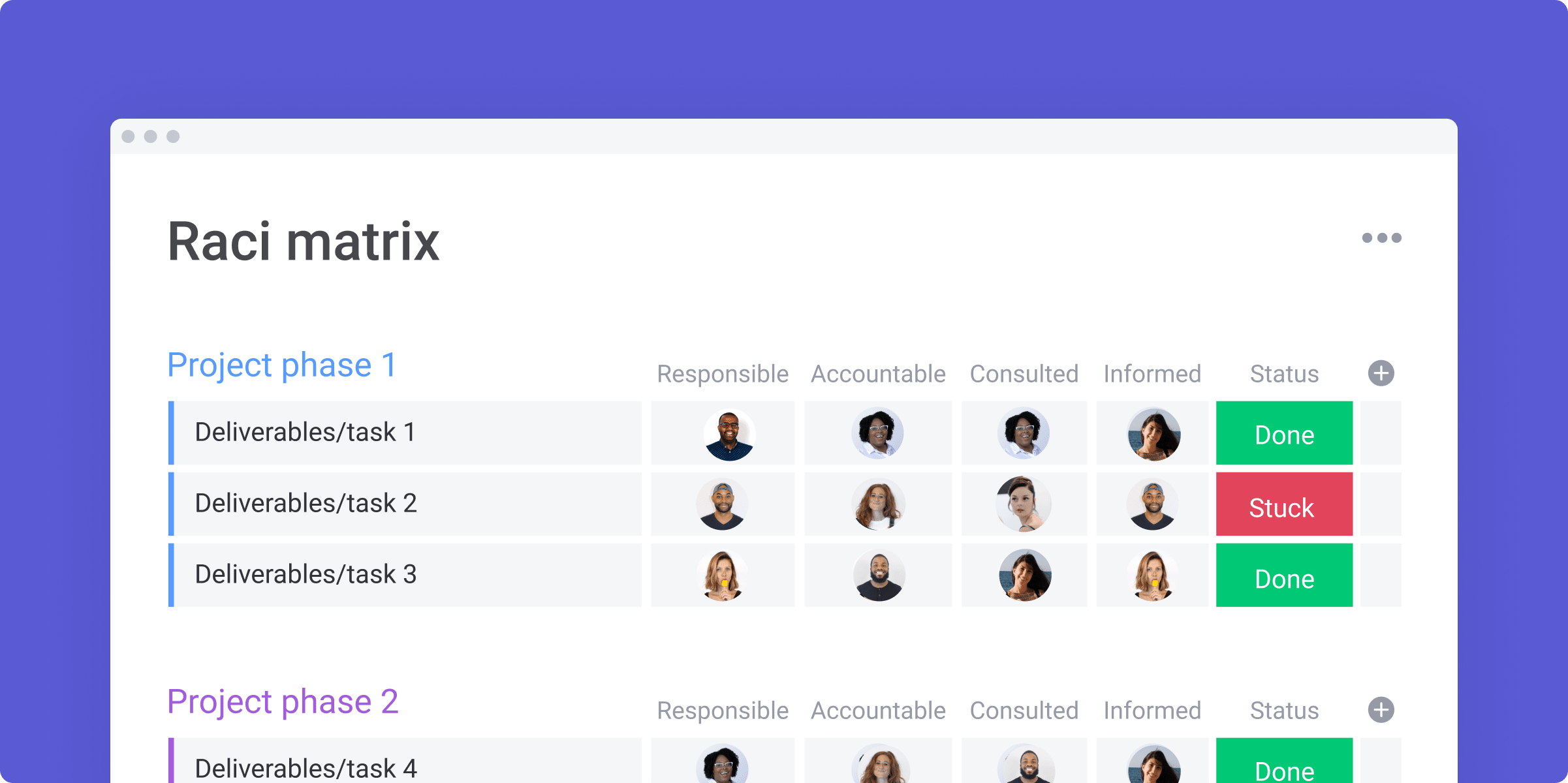
What is a RACI matrix?
RACI is a responsibility assignment matrix that teams use as part of their project management tactics and strategy. Also called a RACI matrix or linear responsibility chart, RACI charts are a type of responsibility assignment matrices in project management. These simple spreadsheets or tables highlight the different states of responsibility a stakeholder has over a particular task or deliverable and denote it with the letters R, A, C, or I. It’s typically implemented by color-coding each responsibility level and creating a simple table layout.
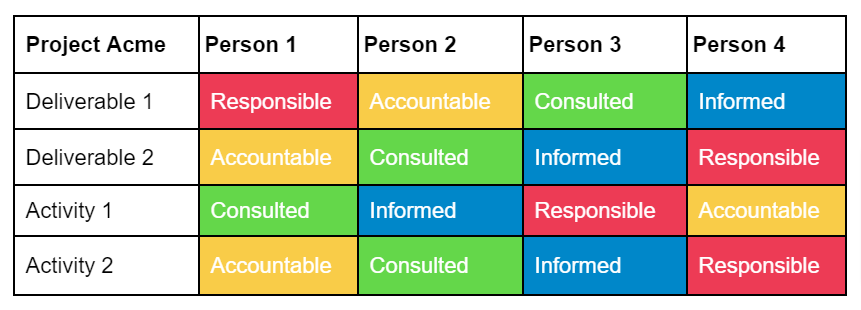
Generally, nobody should have more than a single responsibility level for each deliverable or activity group in the RACI chart. In this example, we’ve given every person some level of involvement to keep things simple. But when you make a real model for more than four people, there’s often more white space. We will get more into how class RACI looks and functions later.
Pro tip: Check out our easy-to-use RACI matrix template
What does the acronym RACI mean?
The letters in RACI stand for:
- Responsible
- Accountable
- Consulted
- Informed
The RACI matrix uses these terms to describe individuals’ roles and responsibilities for project activities and deliverables.
Once your responsibility assignment is complete, all participants should understand precisely what they need to do to make the project successful.
Definitions of RACI terms
Here’s how the RACI chart framework envisions each role and responsibility.
Responsible
The person assigned as Responsible is the individual who is in charge of the day-to-day work of the project including actual hands-on work, delegating responsibilities, and day-to-day management. This function is often held by a project manager, team lead, developer or engineer, designer, or content creator.
Accountable
This role is given to the person who is accountable for making sure the work is completed satisfactorily. This is the individual who signs off that the job is done to the standard required. This function is often a department head, C-level executive, or a product owner.
Consulted
Sometimes, work may require advice or other input from a subject matter expert to get the job done. Allocate the Consulted role to a person whose advice for task completion is necessary. Consultants are typically subject matter experts, legal counsels, financial advisors, UX specialists, and marketing specialists.
Informed
The Informed role is for those stakeholders who need to be kept in the loop as a task progresses. They won’t provide any input on how the task gets done, but are likely a key stakeholder who needs to know what’s happening. This role is held by stakeholders, end users, client representatives, or other department heads.
Benefits of using the RACI model in project management
The proverb—too many cooks spoil the broth—is centuries old. However, Princeton University concluded it was true following their research into the ‘wisdom of crowds’.
You instinctively know when there are too many people getting involved in a specific task. It can even lead to conflict as each team member tries to exert an influence on tasks that shouldn’t need their input.
Without documented roles and responsibilities it’s harder to stop people from moving outside their lane and harming the smooth running of the project.
Using a RACI matrix helps to make sure that each task is only worked on by the right, relevant people.
Further benefits of using the RACI model include:
- It simplifies communication. If only the right, relevant people are involved in a task, this streamlines communication making task completion more efficient.
- It prevents team member burnout. Once you have drawn up the RACI matrix, you can easily see if any team member is overloaded with too many tasks on the project. If your project has a single person shouldering most of the load, it creates a weak link that could spell disaster for the project if that person fails to deliver.
- It provides clarity of purpose. Clarity of roles gives team members a purpose. If everyone can figure out immediately what they and others are doing using the RACI matrix, then this should result in a smoother workflow
Call a meeting for all the project’s stakeholders to produce a RACI matrix together, where you can get agreement on this new iteration of everyone’s roles and responsibilities.
When you should use RACI
The RACI model is a great solution when multiple people are involved in a project and you need clarity. It helps avoid searching for answers across multiple team members and stakeholders. Another bonus of using RACI is that it gives team members confidence. Everyone knows exactly what they are responsible for and who to turn to when necessary.
A large scale project could involve many stakeholders, such as:
- Government regulators
- VIP clients and project sponsors
- Company executives
- Business analysts
- Internal users of the product
- Customers
- Suppliers
- Investors
When RACI is used from the beginning, teams are able to avoid miscalculations and blunders that could cost precious time and money. And of course, it will contribute to your overall stakeholder engagement efforts.
How do you create a RACI chart?
You can create a RACI chart using a simple grid, but it’s better to use a digital workspace so you can easily update and fix it.
Get a head start with our monday work management RACI chart template
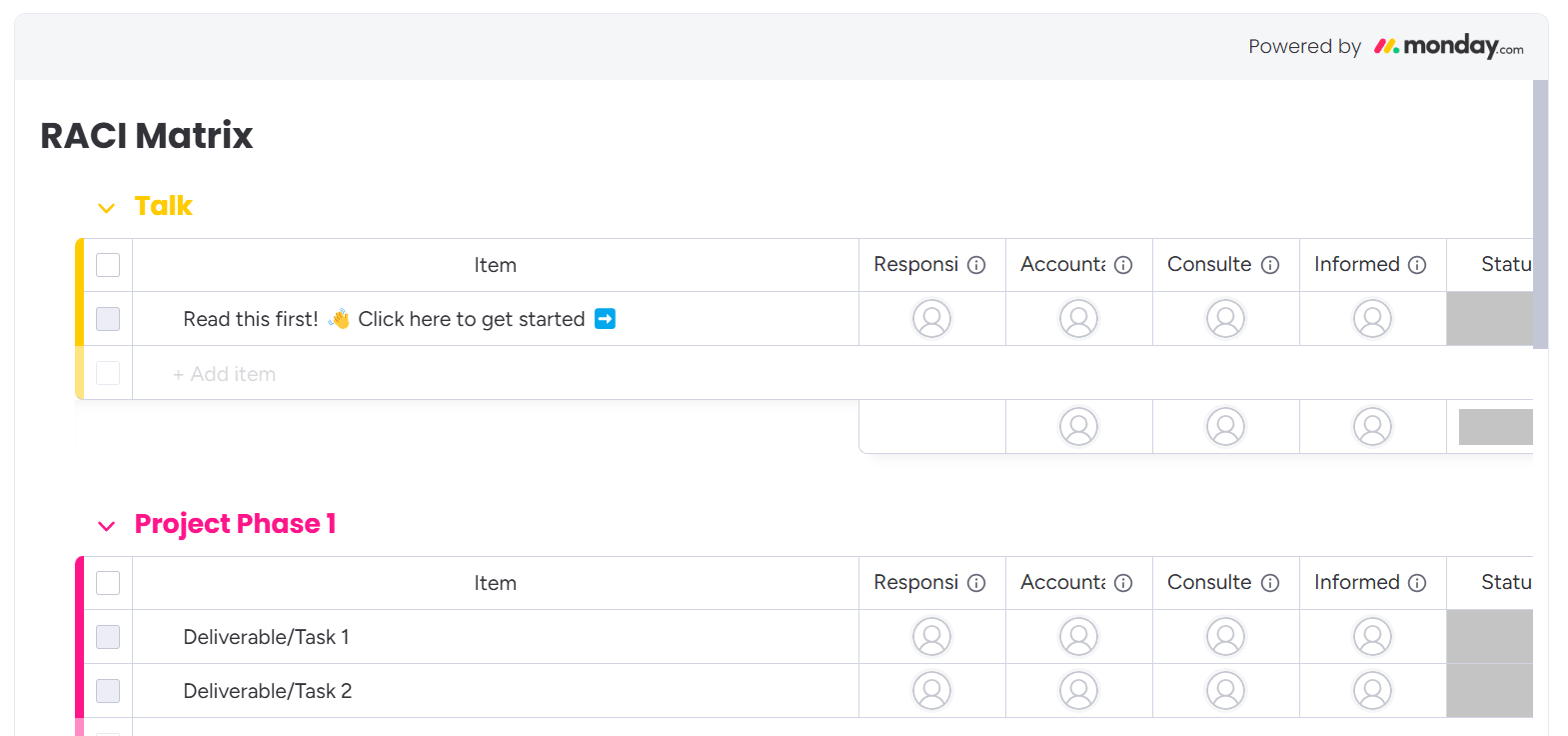
On the left of the RACI diagram, split your project into logical phases, and note down all of the action items that require completion. Along the top of the matrix, the four project roles of the RACI model are already entered for you.
Next, where a task and role intersects, add in the person who will assume the role. Here’s an example containing a few common tasks for a new product launch:
| Responsible | Accountable | Consulted | Informed | |
|---|---|---|---|---|
| Packaging Design | Mary | Jane | Stephen | Graham |
| Advertising Campaign | Jane, Stephen | Jane | --- | --- |
| Manufacturing QC | Graham | Susan | Mark | Jane |
| Shipping Logistics | Janice | Stephen | --- | --- |
There are a few rules to stick to when you compose your RACI chart.
To make sure a task gets done, each one should have someone allocated as Responsible. Similarly, it’s best practice for every work item to have someone Accountable, too, so they can sign off the task when it’s finished.
For large tasks you can assign more than one person to each of the roles, if needed. Or if it makes sense, you can have the same person allocated to a deliverable as both Responsible and Accountable. As you can see in the above example, not all tasks require a Consulted or Informed person ― you don’t have to assign these roles if you don’t need them.
Now let’s move on to understand the benefits of using a RACI diagram to define roles for a project.
RACI best practices
There’s no need to reinvent the wheel when it comes to building your RACI charts. Here are some of the best practices that we recommend sticking to:
1. Map out deliverables and activity groups thoroughly before using RACI
Don’t jump immediately into assigning individual responsibilities. Start by consulting with subject matter experts and accurately mapping out the moving parts. Only once you’ve got a clear outline of your project can you make educated decisions. That could be your Work Breakdown Structure (WBS) or a project roadmap.
2. Don’t be afraid to give responsibility to less senior staff
Assigning the accountable role to a high-level executive or project manager for all tasks is a mistake. Since they have the final say on when a job is complete, you instantly create a bottleneck. Instead, don’t be afraid to assign that role to experienced staff on the project team itself, who is most familiar with the work.
3. Standardize the approach across departments and locations
While a single project team is good, stakeholder relationships don’t exist in a vacuum. Your whole organization must get on board to truly maximize the return on investment. Make distributed responsibility and decision-making part of your corporate purpose. Everyone — from executive to intern — must be on the same page.
4. Each task must have at least one Responsible person and only one Accountable person
The goal here is to avoid overwhelm, not increase it. That’s why it’s critical to have one accountable role for each task to make decision making as easy as possible.
5. Use the right digital tools to implement RACI at scale
A written memo isn’t enough to standardize your methods and remove departmental silos. Use digital tools to build a platform for efficient RACI implementation and stakeholder management.
RACI chart examples
A RACI matrix sounds great in theory, but how do you apply it in the real world?
Here are a few examples:
Launching a new help page on your corporate website:
- Ultimately, the design team would be Responsible for completing the work.
- The project manager would be Accountable for most of the tasks, which would be broken down one by one on the matrix.
- The head of customer support — whose team will be most directly impacted by the new help page — might be Consulted on the section’s contents.
- Lastly, the marketing team would be Informed of the outcome so they could promote the new section.
Creating a new employee onboarding program:
- Members of the human resources (HR) team would likely be Responsible for ensuring the work is done.
- The director of HR would ultimately be Accountable for the final product.
- Each team lead would be Consulted as they wanted to ensure their team was represented in the training.
- Finally, members of the C-suite may want to be Informed about the final product.
No matter what type of project or task your team is working on, the RACI model can provide a great solution for allocating responsibilities and avoiding confusion.
The pros and cons of RACI
It’s clear that using RACI charts boosts organization and often clearer communication, but like anything else, RACI also has its downside. Let’s take a look at the pros and cons.
Pros
Using a RACI chart can bring several advantages to project management, enhancing efficiency, clarity, and team alignment:
- Communication with stakeholders is clearer and more organized
- Team leads can avoid assigning too much responsibility to specific team members
- Give visibility to stakeholders to understand what is in the pipeline and what is coming their way
Cons
RACI charts can also present challenges, including potential confusion, tension, and delays among team members:
- Roles can be confusing in the beginning (for example, understanding the difference between Accountable and Responsible)
- Tension may exist between Consulted and Informed stakeholders
- Setting up a RACI chart may require an initial time investment
RACI matrix alternatives
As the RACI chart is a simple project plan at its heart, it’s flexible enough for you to optimize it to fit your particular need. Especially when you’re using a fully customizable template like the one from monday.com.
There are many variants of the RACI matrix that have tried to address the ambiguities with role names, or added in new roles entirely. Here are a few alternatives you could use instead.
DACI
The DACI chart uses the following role definitions to reduce the confusion caused by Responsible and Accountable in RACI.
- Driver: the person who ‘drives’ the task forward (Responsible in RACI)
- Approver: the person who signs off the task (Accountable in RACI)
- Contributor: the Consulted role in RACI
- Informed: same as RACI
RASCI
The RASCI chart uses the RACI format but adds in the additional role of Support. This role is a person who assists the Responsible person in completing an allocated task. They won’t provide advice like the Consulted role or be the main driver for task completion.
CARS
The CARS model attempts to define the roles of RACI in a more precise manner and adds in a supporting role like the RASCI model.
- Communicate: combines the Consulted and Informed roles in RACI.
- Approve: uses more explicit language for the Accountable role in RACI.
- Responsible: same as RACI role.
- Support: uses the same support role as the RASCI model.
CAIRO
The CAIRO model expands RACI by adding in the letter O (and jumbles up the letters). The letter O is for Out-of-the-loop and is for situations where you need to designate an individual or team as not involved in a task at all.
RACI vs. RASCI
The terms RACI and RASCI are largely used interchangeably today. As mentioned above, RASCI is the same as RACI but adds support into the mix. The Support function makes sure that the Responsible team member has everything he/she needs to get the project done. This can be helpful on larger projects where more assistance is needed.
Who uses a RACI matrix?
Even though the RACI model is a project manager’s useful tool for stakeholder management, that doesn’t mean it should be used for all projects. The deciding factors on who uses it relate to the scale of the project and the company structure.
Use the RACI matrix for projects that are:
- Large-scale with clear-cut deliverables or workgroups
- For organizations with static roles and responsibilities
- Involving a wide variety of stakeholders for different aspects
- Spanning multiple departments
- In highly regulated industries
Don’t use the RACI matrix for:
- Small, single-department projects — it’s likely not necessary
- Teams working with an Agile framework like Scrum
In Agile organizations, cross-functional teams and collaboration is the default. So task responsibility depends on the employees’ initiative rather than a top-down decision. For Agile teams, implementing a hard version of RACI will likely not be helpful, as teams should be self-organizing.
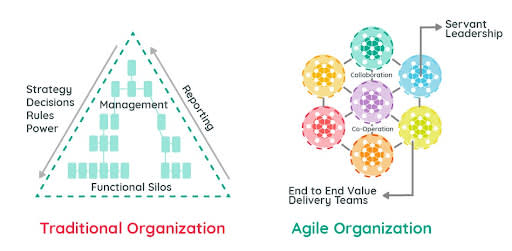
RAPID vs.RACI— What’s the difference?
Sometimes when you want to define RACI, it’s important to use another method for comparison.
RAPID and RACI are both two important tools for project managers, but they have different functions. As we have seen, the RACI method revolves around deliverables and the key person responsible throughout each stage of the process. RAPID however, focuses primarily on the decision-making process and the actions made by an organization.
You can see the breakdown of RAPID here:
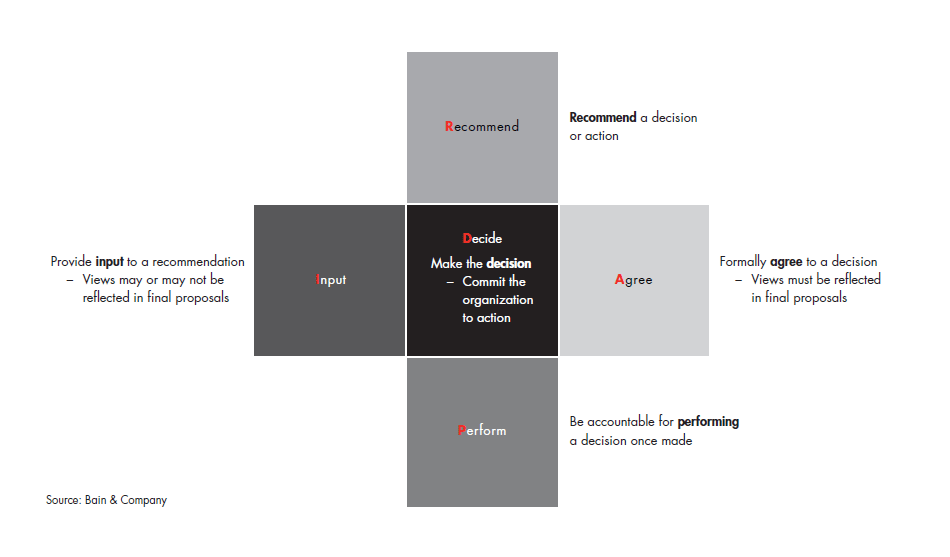
While making a key decision is a part of the project management process, it’s not the whole journey. The RACI framework outlines who should do a task, who to keep in the loop, and who gets the final say.
How to create a RACI chart with monday work management
While there is a wide variety of project management apps out there, in the particular case of a RACI, monday work management provides an outstanding offering of robust integrations and extensibility that allow you to build the exact platform you need to manage this structure and more.
You can get started much quicker with our RACI matrix template and share it with the entire team. Keep track of the RACI roles for all project activities and easily see project phases and individual deliverables for each.
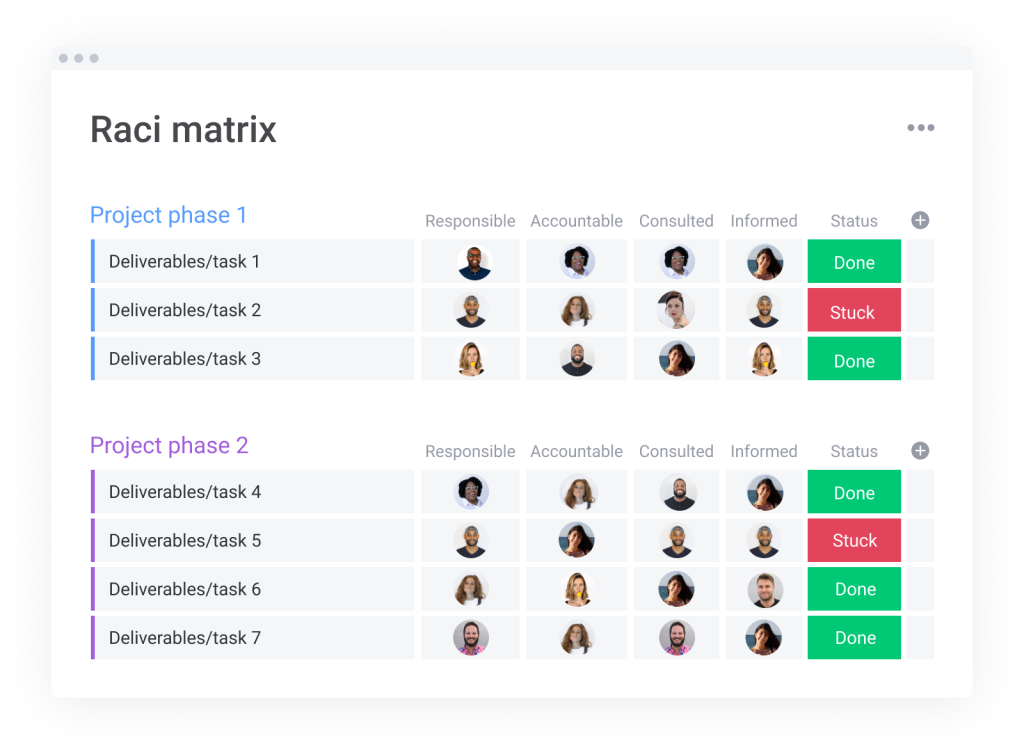
In addition to customizations on columns, statuses, and more, easily assign roles to internal users or guest users created for external stakeholders. All assigned roles will automatically get informed of status changes to the work item.
Here are a few more ways you can get the most out of your RACI matrix.
Continually update and revise to reflect the real-time statuses
An out-of-date RACI diagram helps nobody. Use board permissions to let responsible users directly edit the status of the row themselves.
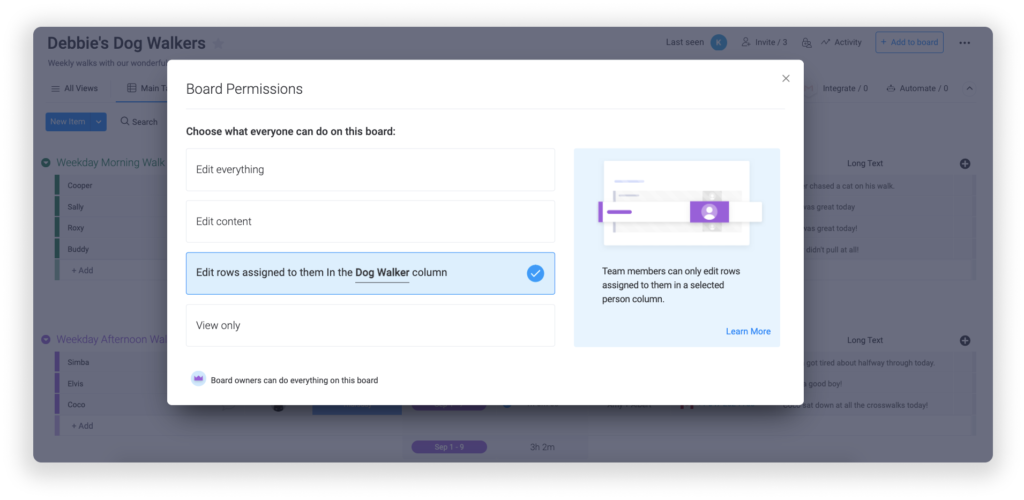
Keep stakeholders involved with shared boards and dashboards
With monday.com, you can easily give them viewer access to project and workflow boards. That way, they know the actual status of the project in real-time. They can then use that information to guide their decisions. You can also inform stakeholders of crucial changes automatically with automations.
Our integrations with Slack, Microsoft Teams, and Gmail let you send messages based on status changes, new items, missed due dates, and more.
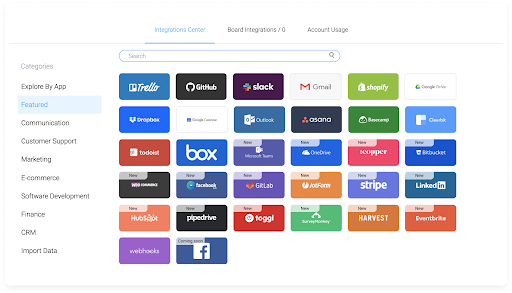
Remove data silos to keep everyone on the same page
Naturally, every department uses a different set of tools and applications. monday.com’s robust integrations make it easy to bring all of this data And even if you use custom business apps, you can easily integrate them into monday.com using our API and 50+ pre-built adaptors.
Empower stakeholders with RACI charts
The RACI matrix is an excellent method for assigning responsibilities and keeping stakeholders engaged throughout the journey because it clarifies where everyone should focus their energy and makes it easy for people to lead the way in their area of expertise.
That being said, the platform and tools you use to make it automated and up to date can have a significant impact on its success. Use our RACI template and share it with your entire team to ensure everyone understands and deals with it accordingly.
FAQs
What are the four rules under the RACI chart?
The four rules in RACI are Responsible, Accountable, Consulted, and Informed. In the RASCI model, a fifth rule, Support, is added.
What is the difference between the R and A in RACI?
The Responsible role is the person responsible for executing the task/project. The Accountable person is ultimately in charge of making sure the project is completed and is the project owner.
What is the golden rule of RACI?
The golden rule of RACI charts is that only one person can be assigned the Accountable role for each project.
Can the same person be accountable and responsible in RACI?
Yes, the same person can be both Accountable and Responsible in RACI. The Accountable status can only be assigned to one person, as this is the ultimate authority and owner of the task.
Which software is best for RACI?
monday.com makes it easy to build effective and visual RACI charts. Assign team members the different roles at the click of a button so everyone can stay informed and understand their part in getting the project completed well and on-time.
Don’t miss more quality content!
